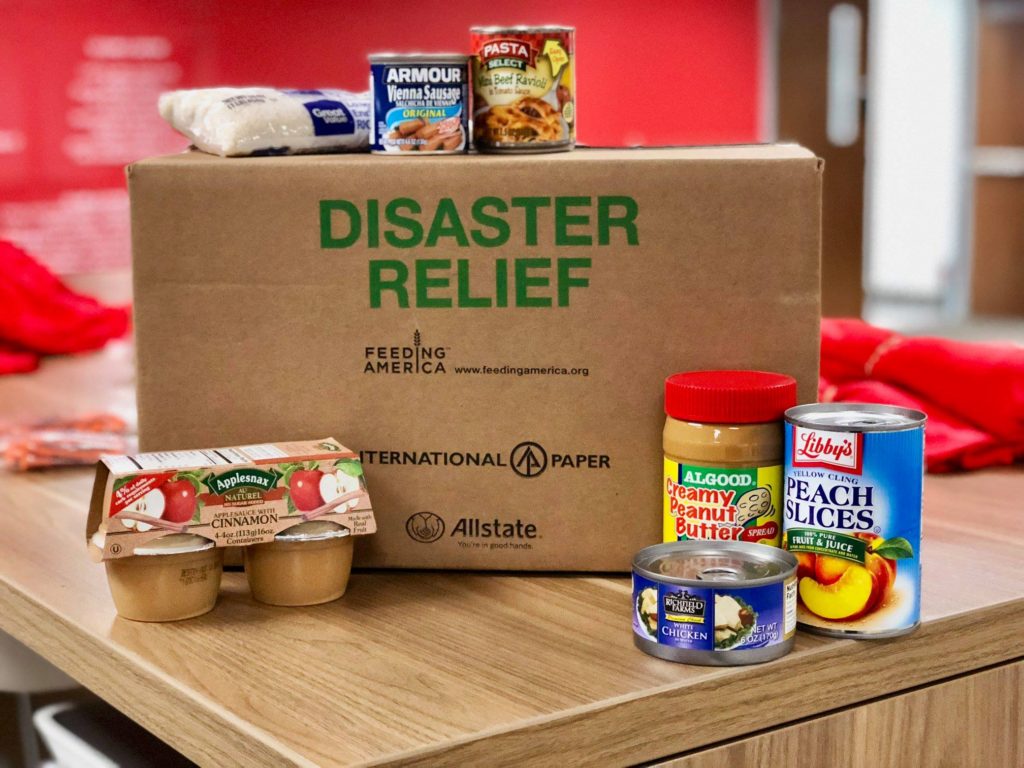Feeding
Feeding is the provision of food, snacks, and hydration to the affected population and emergency workers. It often begins with the whole community, starting with the local food banks, restaurants, and caterers and then transitioning to non-profit organizations that are noted for their disaster feeding expertise. Feeding can be provided at fixed and mobile sites. Feeding requirements are based on the demographic, cultural, dietary, and ethnic diversity of a community.

The Feeding function provides meals, snacks, and beverages to individuals and families in communities impacted by man-made and natural disasters, ranging from single-family fires to large-scale events, such as tornadoes, hurricanes, and floods. Feeding includes the preparation, coordination, and delivery of meals through the following methods:
Congregate feeding—providing meals and beverages in a shelter.
Outreach feeding—providing meals and beverages either at a fixed, non-shelter location in or near a disaster-affected area or by using emergency response vehicles (ERV) that travel throughout affected communities.
Canteening—providing snacks, beverages, and sometimes meals to first-responders, shelter clients, and others who need their nutrition needs to be met outside of scheduled meal times.
Infant/Toddler Feeding Support in Shelters
Meeting the Needs of the Entire Family
Ensuring adequate nutrition for the entire family following a disaster is a critical part of the Mass Care mission. Families with young children are especially vulnerable given the specific needs and unique challenges associated with caring for infants and toddlers. This is particularly true when families are displaced from their homes and must seek shelter in a congregate setting. Emergency Managers are strongly encouraged to plan and provide resources for mothers who may require additional support to continue feeding their children as they would at home, whether through breast milk or infant formula. This can include establishing specific areas for breastfeeding and for bottle washing as addressed in the Multi-Agency Shelter Plan Template.
Federal Support for Infant Formula and Breastfeeding Equipment in Shelters
There are two potential methods to secure federal assistance for infant formula and breastfeeding equipment for use during mass care/sheltering operations during a federally declared disaster when Section 403 is authorized and state, local, tribal, and territorial (SLTT) resources are exceeded. One is through Direct Federal Assistance and the other is through reimbursement under Public Assistance.
One method available to SLTTs is to request reimbursement through FEMA Public Assistance after securing the resources through their own sources. These resources serve as an emergency protective measure, necessary to sustain and support human life.
The Federal share is not less than 75 percent of the eligible costs for either method of assistance.
The other, Direct Federal Assistance is initiated by state, tribal or territorial (STT) government when a Resource Request Form is submitted to FEMA for the provision of a specified resource. FEMA then identifies the most appropriate source to meet the request and arranges for transportation and delivery of the resource to the identified location. This method would be appropriate when the STT lacks the capability to secure such resources, which serve as emergency protective measures to sustain and support human life.
Resources for Mass Care Providers
CDC: Infant and Young Child Feeding in Emergencies Toolkit
CDC: Creating Safe Family-Friendly Spaces in Emergency Shelters
CDC: Infant Feeding Donations in Emergencies
CDC: Dudas respecto a donaciones de fórmula para bebés y artículos para alimentar a los bebés durante una emergencia
Resources for Families
CDC: How to Prepare and Store Powdered Infant Formula During an Emergency
CDC: Preparation of Breast Milk – Storage
CDC: Cup Feeding Infants During Emergencies
CDC: Protect your Baby from Cronobacter
CDC: Emergency Kit Checklist for Kids and Families
CDC: Como Preparar y Almacenar Formula Infantil En Polvo
CDC: Preparacion de la Leche Materna
CDC: Extracción de leche a mano
CDC: Cómo alimentar a un bebé con un vasito durante las emergencias
Training
Community Preparedness: Integrating the Needs of Children
MULTIAGENCY FEEDING SUPPORT PLAN TEMPLATE (JUNE 2015)
The purpose of this template is to define the framework for State and/or Federal support of a coordinated, timely and efficient feeding response within a jurisdiction. It also defines the full spectrum of services required from initiation until community services are restored. This multi-agency feeding plan along with the coordinating body, the Multiagency Feeding Task Force, has been developed as an integrated strategy and process for implementing coordinated feeding operations at the jurisdictional level. The multi-agency feeding plan will help to limit duplication of efforts and maximize use of available resources.
HOUSEHOLD DISASTER FEEDING OPERATIONAL PROCEDURE: A STATE TEMPLATE (JULY 2012)
This guidance document assists jurisdictions in the development of a procedures for household disaster feeding. The document outlines procedures for the acquisition, assembly and distribution of food items for household distribution in a disaster within the context of a Multi-Agency Feeding Task Force. The focus stresses coordination and collaboration by the various stakeholders during preparedness, response and recovery.
